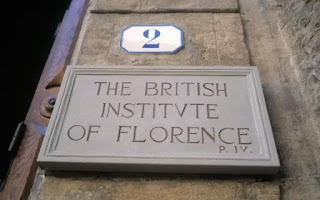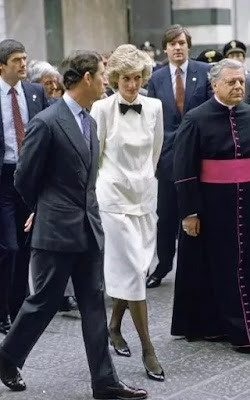Harry Mount
Today, the Prince of Wales
will tour the British Institute in Florence – and step back in time to a
pre-war, Anglo-Italian idyll untouched by the ravages of the 20th century.
This year, “Il British”, as
the Italians affectionately call it, celebrates its centenary. In honour of its
100th birthday, Prince Charles, the Institute’s patron, will chat to art
history and English language students.
The Royal family know the
place well: Charles visited with Princess Diana in 1985. And, in 2000, the
Duchess of Cambridge was one of those art history students. The then Kate
Middleton was typical of a certain type of British Institute student – Sloaney
girls with thick manes of glossy hair, gently acquainting themselves with the
Renaissance between public school and university; in Kate’s case, Marlborough
and St Andrews.
We’ve been outside the EU
for longer than we’ve been in it. And so, in time to come, institutions like
the British Institute in Florence will become increasingly important
I studied Italian and art
history at the Institute in 1995 and 1998. And, it’s true, you would often hear
that distinctive sound – of upper-middle class girl bellowing unto upper-middle
class girl across the Arno – as we made our way from palazzo to palazzo.
In fact, the Institute
itself was a much more serious place than that. Its art history and Italian
classes were first-rate – and now its teachers also teach English in Florence
state schools, as well as teaching English to the shop assistants in Chanel and
the room stewards at the Uffizi Gallery.
The overpowering
enchantment of the Institute derives from its two settings: first, the Palazzo
dello Strozzino, an elegant 1458 pile designed by Brunelleschi, who also built
the nearby Duomo. This is where language lessons take place.
Then, across the Arno, lies
the Harold Acton Library, housed in the Palazzo Lanfredini, a 15th-century
palace left to the Institute by the aesthete Sir Harold Acton on his death in
1994.
Talk about a room with a
view! I have spent some of my happiest hours in the high-ceilinged rooms of
that palazzo, staring across the Arno to the Palazzo Corsini on the other side
of the river. The Harold Acton Library is the biggest English language lending
library on the Continent. I passed lazy afternoons reading Anthony Powell and
Evelyn Waugh, who partly based Anthony Blanche in Brideshead Revisited on
Acton, his old Oxford friend.
The library is crammed with
books on Italy and art history, as well as English papers and magazines. After
a leisurely day of Italian lessons and Renaissance lectures, I’d drift into one
of the Institute’s cocktail parties, or listen to a talk, in English or
Italian, from one of its visiting speakers.
Five years ago, I gave one
of those talks – on “Why Italian Lovers should become Latin Lovers”. I was
delighted to see the cast of Institute characters was unchanged: a few
glossy-maned Sloanes; the odd Italian professore; retired English ex-pats in
crumpled linen. I wouldn’t have been surprised if Helena Bonham-Carter, Maggie
Smith and the rest of the Merchant Ivory gang suddenly strolled into this
Edwardian scene, straight out of A Room with a View.
Seventeen years older than
the British Council, the British Institute was the first British cultural body
to open abroad
As Italy has stumbled
through world wars and countless governments, the British Institute has
remained much the same. Seventeen years older than the British Council, it was
the first British cultural body to open abroad. The intention was to bring
Italy and Britain closer together, through the study of English, Italian and
art history; the desire for unity was particularly strong at its foundation, in
the middle of the First World War. It’s never stopped unifying since, apart
from the wartime closure between 1940 and 1946.
“The Institute’s mission
remains absolutely as it was,” says Julia Race, Director of the British
Institute. “We’ve been outside the EU for longer than we’ve been in it. And so,
in time to come, institutions like this will become increasingly important.”
The Institute gets no money
from the Government – meaning its grandness isn’t underpinned by great wealth.
But it does mean the Institute remains gloriously independent and original.
“It’s wonderfully
eccentric,” says Lady Roberts, the former Royal Librarian, who is the British
Academy Representative Governor at the Institute. She studied at the Institute
in 1967. “It even smells good! The archive has some wonderful things. It was a
very scholarly place. The best thing about it is that all Florence is around
you. It’s the most perfect place to learn art history. You stumble out of the
library, cross the bridge over the Arno, and you think you’re in heaven.”
Her husband, Sir Hugh
Roberts, former Director of the Royal Collection, worked for the Institute in
1967, moving books in the library for a few lire a day, before starting his
Cambridge degree.
“You felt like you were
reaching back into Anglo-Italian life of the 19th century, or even further,”
says Sir Hugh. “It has that feel of when Florence was the capital of Italy
[between 1865 and 1871]. It was the gathering of old Florence. Harold Acton was
around. The more beautiful people were taken up to his house, Villa la Pietra.
People from I Tatti [the villa that had belonged to the American art historian,
Bernard Berenson] came tottering down every so often.”
Harry Mount's secret must-sees
St Mark’s English Church Via Maggio
Secreted inside a 15th
century palazzo, St Mark’s has been a home-from-home for English travellers
since it was founded by the Reverend Charles Tooth in 1881. Decorated in
Pre-Raphaelite style, it is a gathering point for ex-pats on Sunday mornings.
The English Cemetery Piazzale Donatello
The last resting place of a
thousand aesthetes. An idyll, scattered with cypress trees, beyond Florence’s
medieval walls. Among the English buried here is the poet, Elizabeth Barrett
Browning, in a tomb designed by Lord Leighton.
The Vasari Corridor The Uffizi
The secret passageway that
connects the Palazzo Vecchio with the Uffizi and the Palazzo Pitti. It sneaks
its way across the Arno, beautifully concealed above Florence’s most famous
bridge, the Ponte Vecchio.
Villa La Pietra Via Bolognese
The colossal Renaissance
villa, perched on the hills above Florence, owned by Sir Harold Acton. Here he
entertained Evelyn Waugh and Princess Margaret. He left it to New York
University.
Palazzo Lanfredini Lungarno Guicciardini
Acton’s town villa, now
home to the Institute’s Harold Acton Library. For 20 euros, you can join the
library for a month, read its books and papers, and luxuriate in one of the
finest rooms in Europe.
Villa La Colombia Via Di Santa Maria a Marignolle
Florence Nightingale’s
birthplace, where she was born in 1820 – thus her first name. The 15th century
villa is now a nunnery, for the Adorers of the Blood of Christ. On a hill above
Florence, it has lovely views of the city.
The Italians, too, hold Il
British in high regard. Later this year, the Italian state will issue a stamp
commemorating the Institute’s centenary. The Institute’s other patron,
alongside Prince Charles, is Wanda Ferragamo, the grande dame of Salvatore Ferragamo,
the Tuscan shoe-making dynasty.
At those evenings in the
Harold Acton Library, alongside the crumpled English linens, you see the
immaculate, super-ironed outfits of the belle donne of Florentine high society.
A century after its foundation, the Institute is still doing its job: bringing
Britain and Italy together in the most Anglo-Italian spot on the planet.
Harry Mount is editor of
The Oldie magazine
http://www.telegraph.co.uk/women/life/italian-finishing-school-teaches-british-upper-middle-classes/



No hay comentarios:
Publicar un comentario